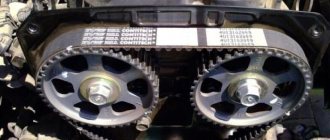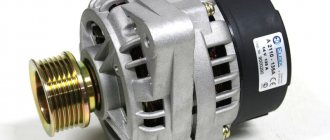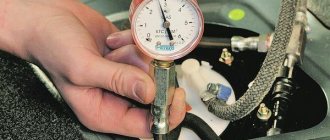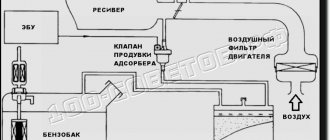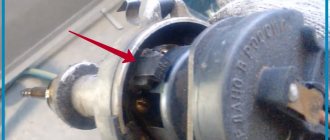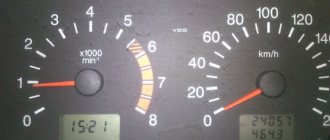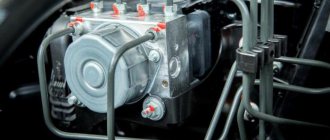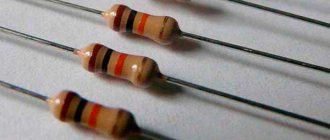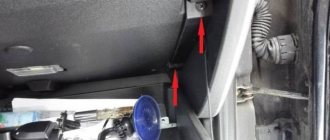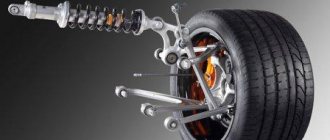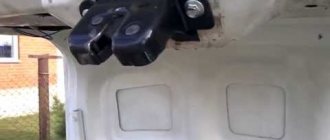02/28/2022 1,787 Dashboard
Author: Ivan Baranov
The tachometer has been mounted on the dashboard next to the speedometer since 1903. This device makes driving easier by showing on the display the number of engine revolutions when you press the gas pedal. Thanks to this, the driver switches gearbox modes in a timely manner.
[Hide]
How does the device work and what does it measure?
The principle of operation of the tachometer is to transform translational action into rotation, the speed of which is measured in revolutions per minute.
The tachometer works according to this principle:
- The driver presses the gas pedal.
- Fuel enters the combustion chamber.
- Here the expansion of existing gases occurs.
- This drives the crankshaft connecting rods.
- The pistons begin to work.
- The number of crankshaft revolutions appears on the display.
The video explains in detail what a tachometer is, how it works and what measurements it displays. Taken from the Avto-blogger channel. ru".
Switching process
When driving straight and during a turn, the driver needs to change the current speed set on the mechanics.
This is done according to a certain algorithm, which can be represented as follows:
- With a tight movement, the clutch pedal is pressed to the floor with the left foot;
- At the same time, you must release your foot from the gas pedal;
- smoothly but quickly select the desired gear on the box;
- when passing the lever, you first return to neutral, and then to the required speed;
- then the clutch is released;
- at the same time, work begins with the gas pedal so as not to lose speed and revolutions;
- After the clutch is fully released, good gas is added.
There are no strict and rigid restrictions in terms of the sequence of transitions at speed. Nobody forces you to shift in a strictly specified order, from 1st to the last gear.
But if you skip speeds, then you will have to spend more time accelerating and the speed will begin to drop.
Types of tachometers
The devices differ in their operating principles and are divided into the following types:
- mechanical;
- digital;
- analog.
Mechanical
This type has the largest number of errors. The measurement accuracy is 500 rpm, which is explained by the imperfect mechanism of action. It is based on the creation of an electromagnetic field. The tachometer is directly connected to the crankshaft using a cable through which impulses pass to a moving coil.
Analog
An analog tachometer is an improved type of mechanical device. The difference is the absence of a special cable. The pulses arrive directly at the moving coil (the more there are, the stronger the magnetic induction). The accuracy of crankshaft rpm measurements ranges from 100 to 500 per minute.
Components of the device:
- magnetic coil;
- chip;
- graduated scale;
- arrow.
Digital
The device is connected to the ignition coil, like an analogue one - directly. The difference is that it accepts the frequency of the signals and their interval (instead of pulses). High accuracy of indicators is provided by data from both sides simultaneously - from the crankshaft and idle speed sensors. The obtained indicators are summed up and the average value is calculated and appears on the device screen.
The digital device consists of the following:
- optocoupler (diagnosis of idle air valves);
- ADC 8 bits;
- processor;
- panels;
- liquid temperature sensor.
The measurement accuracy is 100 rpm.
Important nuances
Ideally, the car should drive without jerking, moving from one speed to another. When buying a used car or a new car, all buyers always look at such a detail as the type of gearbox used. Objectively, the easiest car to drive is considered to be an automatic transmission. But it is important to understand that there are a number of types of gearboxes, and not a simple division into manual and automatic. We recently studied with you the features of sequential gearboxes, and also got to know the variator in more detail. I advise you to re-read and update your own knowledge regarding automobile gearboxes. In terms of reliability and durability, classical mechanics still firmly holds the first position.
When used correctly, the car can accelerate quite quickly, squeezing the maximum out of the installed engine. But when the engine is powerful, and the driver does not know how to shift correctly, then no amount of horsepower will help you.
One general principle applies to all manual transmissions. It consists in the fact that first the clutch is depressed, then the speed is switched, after which the clutch pedal is lowered.
This is interesting: Car air conditioning from the cigarette lighter - we take the “weather” with us!
How to use tachometer information?
It is convenient to use the information obtained from the tachometer when starting the engine in winter. The engine of a cold car produces at least 1000 revolutions when you press the gas pedal. This indicates the inappropriateness of starting the movement. You must wait until the needle in the mechanical device drops to 700 revolutions (or this value appears on the electronic display). When repairing an engine, using the device helps auto mechanics diagnose faults.
The tachometer is capable of showing information about the risk of failure of individual engine parts. This is done using a red arrow or a notch (depending on the type of device). At speeds above 7,000, a dangerous situation occurs for the engine that can lead to breakdowns. The maximum permissible time for maintaining the engine in the “red zone” is 60-120 seconds.
The main mistakes of beginners - what to avoid
There are other recommendations that allow you to understand what a particular gear in a manual transmission is intended for. We need the first to get the car moving, the second to accelerate, and the third to overtake. The fourth and fifth are used respectively for traveling on city roads and country highways.
Beginning drivers make the same typical mistakes. They can't tell by ear that it's time to change gear. Because of this, the engine operates at too high speeds, the car loses speed, and control of movement is lost. Often, beginners cannot get going because they release the clutch pedal too sharply. As a result, the car jerks and stalls. This leads to accelerated wear of some transmission and clutch components. Beginners are often late in turning on second speed. They start the car from a stop, and then accelerate it, forcing the engine to roar annoyingly. At the same time, you can quickly switch from 1st gear to 2nd almost immediately after starting off.
Experienced instructors always teach beginners to take their foot off the clutch pedal immediately after the pedal is released. Firstly, in this case the clutch wears out faster. Secondly, the leg gets much more tired. At the same time, placing the foot on the floor gives the driver an additional point of support and does not put as much strain on the spine. Beginners often suffer from the fact that when changing driving modes, the left hand involuntarily turns the steering wheel, especially if it is in the wrong part of it.
Tachometer malfunctions
The most common situations are:
- the arrow twitches while moving;
- The needle jumps at idle speed.
In the first case, there are malfunctions of the cylinder-piston group of the car engine. The driver must have the car diagnosed as soon as possible.
If the needle twitches mainly during acceleration, the following is possible:
- lack of fuel;
- stretched timing belt;
- The camshaft drive chain is loose.
If the device does not operate properly at idle, the reason is as follows:
- low fuel quality;
- interruptions in sparking (failure of wires supplying voltage);
- mechanical damage;
- fatigue of device components.
Sometimes the following situations arise:
- The screen of the digital device does not light up. LEDs need to be replaced.
- The tachometer constantly gives incorrect measurements. The problem may be with the internal combustion sensor.
When to switch
Switching should be smooth, but at the same time fast.
Many are rightly interested in when exactly it is necessary to switch from one speed to another. Although there are different cars and boxes, there are averages. Namely:
- The first speed is intended mainly for starting, and is not used for active driving. The current speed here is from 0 to 20 kilometers per hour;
- The second speed is accelerating and is used for movement at low speed in the range from 20 to 40 kilometers;
- The driver must switch to third when he needs to accelerate from 40 to 60 kilometers per hour;
- The fourth is suitable for speeds from 60 to 80 kilometers per hour;
- Fifth and sixth speed for driving over 80 kilometers per hour.
These numbers are approximate and average, as there are a number of other factors that affect driving.
The presented diagram is relevant for cars that are not loaded and move along the road without resistance in the form of sand, deep snow or steep inclines. If there is such resistance, then it is recommended to switch to the next gear a little later.
Motorists and driving instructors have developed a useful reminder that they recommend that a beginner remember. The bottom line is this:
- It is always recommended to use first gear solely for starting;
- After the start, you should immediately turn on second speed;
- Second gear serves as acceleration speed on a manual transmission;
- The third is optimal when overtaking;
- The fourth performs best when driving in urban conditions;
- The fifth and sixth are used for expressways, highways and highways.
You can also shift out of order if necessary, shifting from high to low to apply engine braking.
There are a number of visual videos on the Internet about how to properly operate the gearshift lever on a manual car. Both high and low gears are discussed in detail.
Is it possible to determine driving speed using a tachometer?
Sometimes situations arise when it is necessary to determine the speed using a tachometer (the speedometer has failed). If your device allows you to display data in distance units (meters, kilometers), you need to select this function. The determination of the speed of movement will be visible on the board.
In the case where the device only shows revolutions per minute, you can manually carry out the calculations. To do this, you need to measure the time it takes to cover the distance and calculate the speed.
Principle of operation
Drivers who do not understand the mechanical components of the engine must know how the tachometer works in a car. This will help them understand what this device is intended for.
The operation of the motor is based on the transformation of movement (from translational to rotational). This is facilitated by gases that expand and “turn on” the pistons. They, in turn, use connecting rods to spin the crankshaft. Its speed is precisely shown by the tachometer.
The driver, by pressing the gas, forces an increased amount of fuel into the combustion chamber. The pressure increases accordingly, thereby increasing the crankshaft speed and instrument readings.
To make it even clearer how the device functions, we will give a simple example. Let's say the information in the engine documentation reads: 135 horsepower at 3500 rpm. These values indicate that the engine will achieve maximum acceleration at a given crankshaft speed. Low rotation rates will reduce efficiency, which means the machine will move more quietly.
Experts say that if the driver monitors the tachometer readings and switches gears in time, he will achieve effective acceleration. But it is still not recommended to carry out such manipulations constantly. If the speed increases, it means that fuel consumption will also begin to increase. In addition, high speeds will lead to rapid wear of parts. It is best not to “crank” the motor to maximum values. This will help save fuel and extend the life of parts and oil fluid.
How to connect a tachometer yourself?
Step-by-step instructions for connecting a device for a carburetor car look like this:
- The black wire is pulled to the ground of the car.
- The red cord must be connected to the terminal in the ignition switch.
- The third wire is connected to the ignition coil (via a distributor or voltage switch).
- The backlight is connected to the dimensions.
On diesel cars, the tachometer is installed differently:
- The generator protection is disconnected.
- The connection occurs to a specially routed cord on the side of the terminal with the letter W.
- The wire coming from the winding is disconnected and insulated.
Is it necessary to purchase a tachometer and how to choose the right device?
The requirement to have a device for determining the angular velocity of the motor shaft is not regulated in regulations. The driver makes the decision independently, based on personal needs and financial capabilities. If you replace an old tachometer, you must select a new one taking into account the technical characteristics of the car.
If the car owner has decided to install the device, you should pay attention to the following manufacturers:
- Helios (Russia);
- Multitronics (Russia):
- CEM (China);
- KET Gauge (China - Taiwan).
Photo gallery
The photo shows the location of the analog device on the dashboard
Digital tachometer
Device connection diagram
